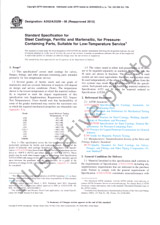We need your consent to use the individual data so that you can see information about your interests, among other things. Click "OK" to give your consent.
ASTM D8304-19
Standard Test Method for Determination of Compounded Forms of Iron in In-service Fluids
Translate name
STANDARD published on 1.12.2019
The information about the standard:
Designation standards: ASTM D8304-19
Note: WITHDRAWN
Publication date standards: 1.12.2019
SKU: NS-983990
The number of pages: 5
Approximate weight : 15 g (0.03 lbs)
Country: American technical standard
Category: Technical standards ASTM
The category - similar standards:
Annotation of standard text ASTM D8304-19 :
Keywords:
corrosion, iron compounds, oil analysis,, ICS Number Code 75.100 (Lubricants, industrial oils and related products)
Additional information
| Significance and Use |
|
5.1 This test method is applicable for determining the level of iron contamination in lubricating oils from sources other than physical wear of the machinery or equipment, such as corrosion. It is particularly suited for oils from engines running on sulphur containing fuels where acidic combustion by-products can enter the lubrication system and cause corrosive damage. The test can be performed at the point of use as it does not require extensive laboratory equipment allowing timely intervention if necessary. |
| 1. Scope |
|
1.1 This method covers a procedure for determining the concentration of compounded forms of iron in in-service fluids. It is applicable over an iron concentration range of 20 mg/kg to 800 mg/kg (ppm by mass hereafter). The test is not sensitive to metallic iron and thus provides a means of discrimination between the two forms of iron. It is suitable for monitoring the condition of equipment where iron contamination in the lubricating oil or functional fluid may not originate solely from physical wear, for example from corrosion or other forms of undesirable chemical processes within the equipment. 1.2 Units—The values stated in SI units are to be regarded as standard. Concentrations are reported as parts per million by mass (ppm) equivalent to iron contents expressed in mg per kg of oil sample (mg/kg). 1.3 This standard does not purport to address all of the safety concerns, if any, associated with its use. It is the responsibility of the user of this standard to establish appropriate safety, health, and environmental practices and determine the applicability of regulatory limitations prior to use. 1.4 This international standard was developed in accordance with internationally recognized principles on standardization established in the Decision on Principles for the Development of International Standards, Guides and Recommendations issued by the World Trade Organization Technical Barriers to Trade (TBT) Committee. |
We recommend:
Updating of laws
Do you want to be sure about the validity of used regulations?
We offer you a solution so that you could use valid and updated legislative regulations.
Would you like to get more information? Look at this page.




 Cookies
Cookies
